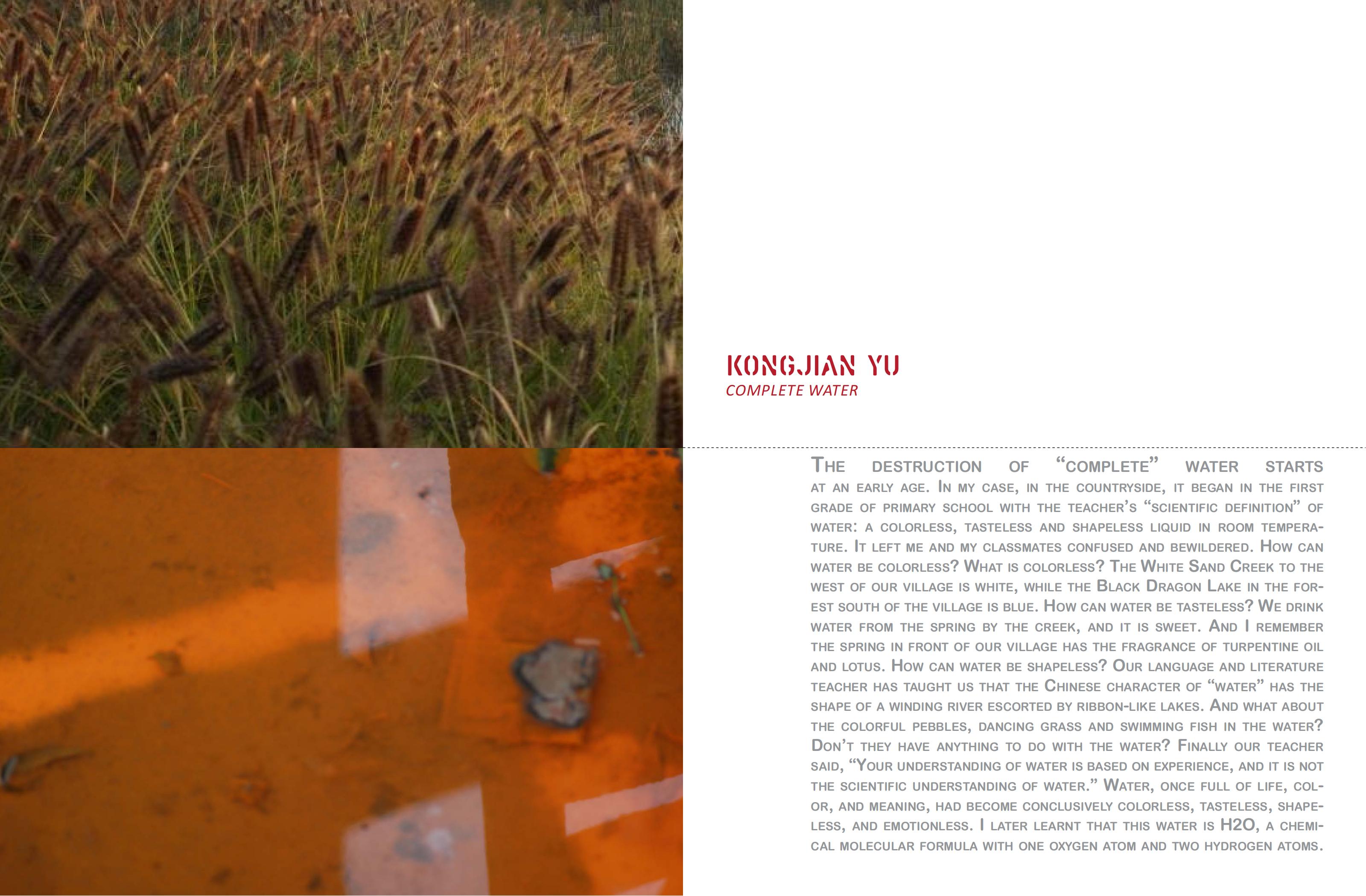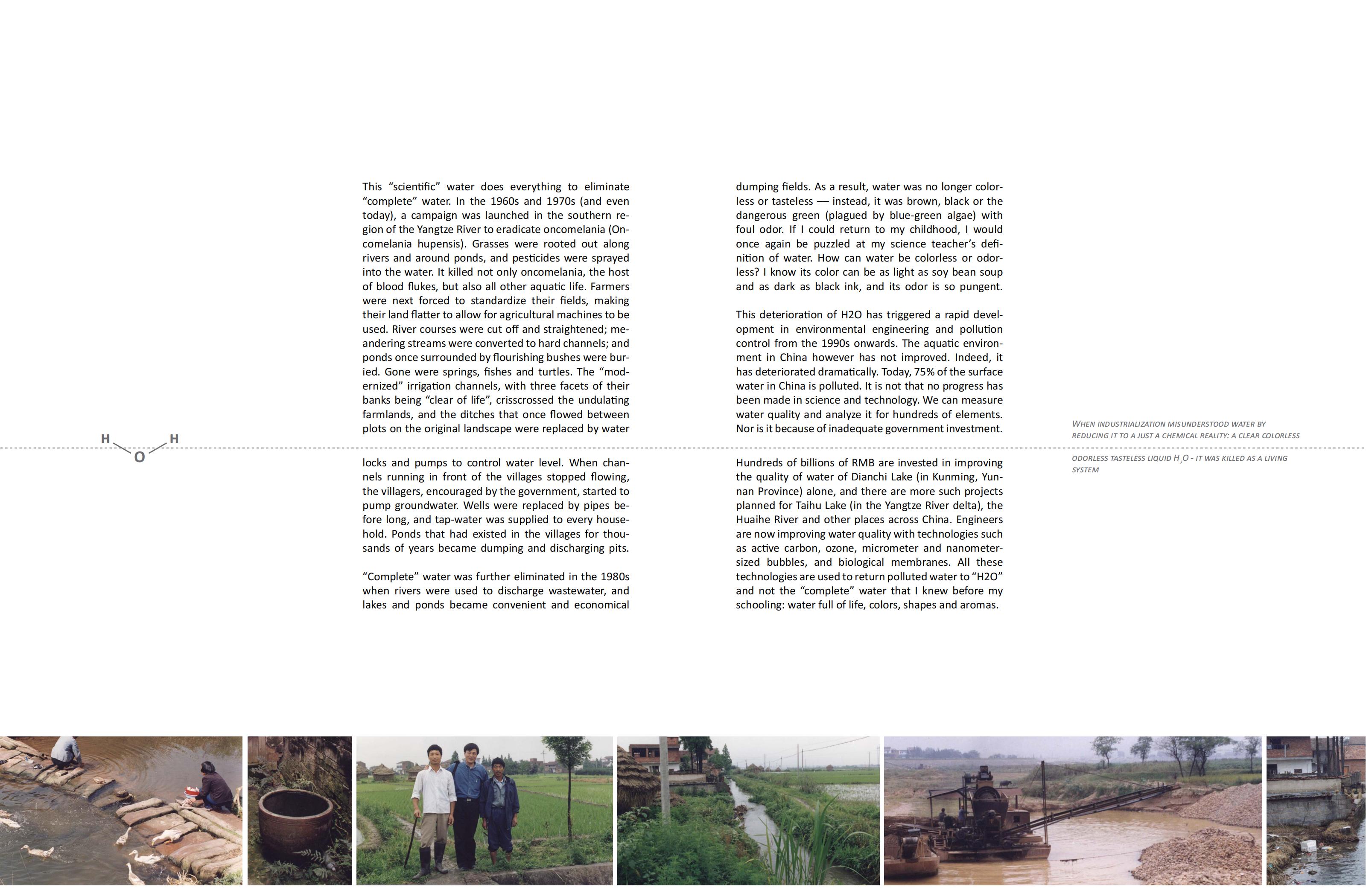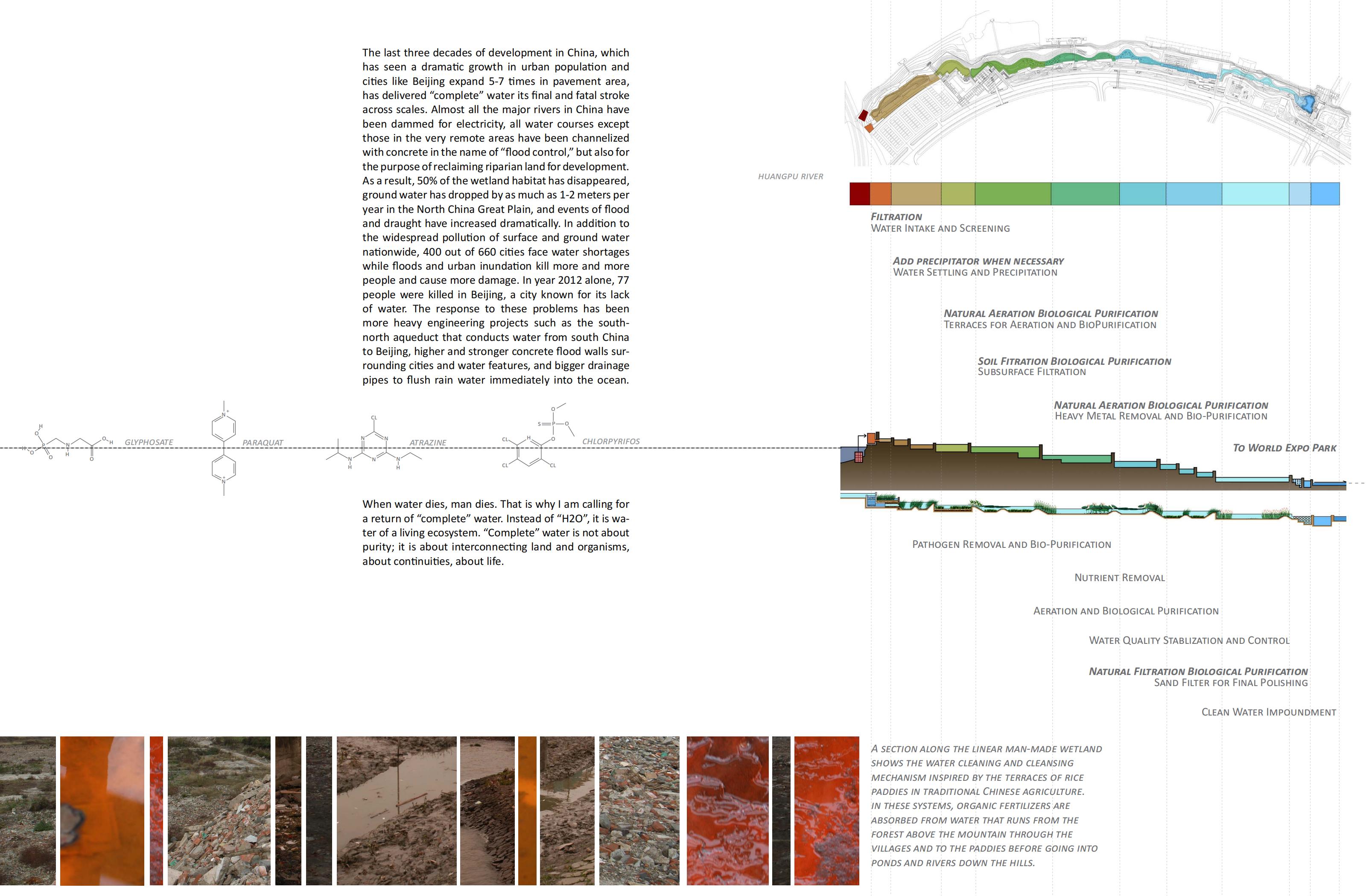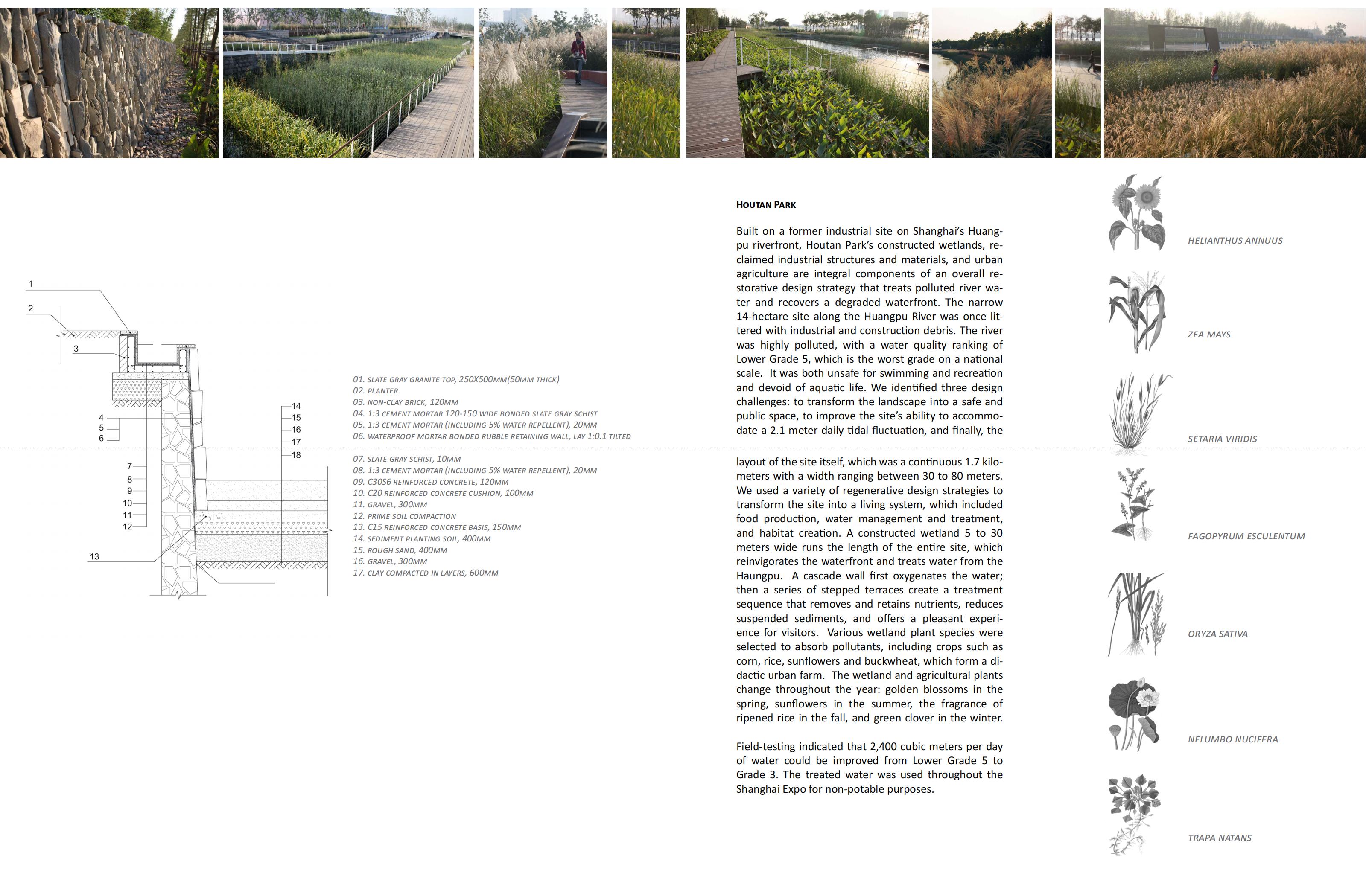Complete Water
- 摘要:
- AT AN EARLY AGE. IN MY CASE, IN THE COUNTRYSIDE, IT BEGAN IN THE FIRST GRADE OF PRIMARY SCHOOL WITH THE TEACHER's "SCIENTIFIC DEFINITION" OF WATER:A COLORLESS,TASTELESS AND SHAPELESS UQUID IN ROOM TEMPERA-TURE. IT LEFT ME AND MY CLASSMATES CONFUSED AND BEWILDERED. How CAN WATER BE COLORLESS?WHATIS COLORLESS?THE WHITE SAND CREEK TO THE WEST OF OUR VILLAGE IS WHITE,WHILE THE BLACK DRAGON LAKE IN THE FOR ESTSOUTHOFTHEVILLAGEISBLUE.HOWCANWATERBETASTELESS?WEDRINK WATER FROM THE SPRING BY THE CREEK,AND IT IS SWEET.AND I REMEMBER THE SPRING IN FRONT OF OUR VILLAGE HAS THE FRAGRANCE OF TURPENTINE OIL AND LOTUS. How CAN WATER BE SHAPELESS? OUR LANGUAGE AND LITERATURE TEACHER HAS TAUGHT US THAT THE CHINESE CHARACTER OF "WATER" HAS THE SHAPE OF A WINDING RIVER ESCORTED BY RIBBON-LIKE LAKES.AND WHAT ABOUT THE COLORFUL PEBBLES,DANCING GRASS AND SWIMMING FISH IN THE WATER?DoN'T THEY HAVE ANYTHING TO DO WITH THE WATER?FINALLY OUR TEACHER SAID,"YouR UNDERSTANDING OF WATER IS BASED ON EXPERIENCE,AND IT IS NOT THE SCIENTIFIC UNDERSTANDING OF WATER.”WATER,ONCE FULL OF LIFE,COL-OR,AND MEANING,HAD BECOME CONCLUSIVELY COLORLESS,TASTELESS,SHAPE-LESS,AND EMOTIONLESS.I LATER LEARNT THAT THIS WATER IS H2O,A CHEMI-CAL MOLECULAR FORMULA WITH ONE OXYGEN ATOM AND TWO HYDROGEN ATOMS.
文献来源:Kongjian Yu, Complete Water[M]. Anuradha Mathur and Dilip Da Cunha (eds.) Design in The Terrain of Water. Applied Research + Design Publishing with the University of Pennsylvania, School of Design.2014, 57-65.
This "scientific" water does everything to eliminate "complete" water. In the 1960s and 1970s (and even today), a campaign was launched in the southern region of the Yangtze River to eradicate on comedian(On-comedian pensions). Grasses were rooted out along rivers and around ponds,and pesticides were sprayed into the water. It killed not only noncompliance, the host of blood flukes,but also all other aquatic life.Farmers were next forced to standardize their fields, making their land flatter to allow for agricultural machines to be used. River courses were cut off and straightened; meandering streams were converted to hard channels;and ponds once surrounded by flourishing bushes were buried. Gone were springs, fishes and turtles. The"Modernize" irrigation channels, with three facets of their banks being "clear of life", crisscrossed the undulating farmlands, and the ditches that once flowed between plots on the original landscape were replaced by water locks and pumps to control water level. When channels running in front of the villages stopped flowing, the villagers,encouraged by the government,started to pump groundwater. Wells were replaced by pipes be-fore long,and tap-water was supplied to every house-hold. Ponds that had existed in the villages for thou-sands of years became dumping and discharging pits.
"Complete" water was further eliminated in the 1980s when rivers were used to discharge wastewater, and lakes and ponds became convenient and economical dumping fields. As a result, water was no longer color-less or tasteless —— instead, it was brown, black or the dangerous green (plagued by blue-green algae) with foul odor. If I could return to my childhood, I would once again be puzzled at my science teacher's definition of water. How can water be colorless or odor-less? I know its color can be as light as soy bean soup and as dark as black ink, and its odor is so pungent.
This deterioration of H2O has triggered a rapid development in environmental engineering and pollution control from the 1990s onwards. The aquatic environment in China however has not improved. Indeed, it has deteriorated dramatically. Today, 75% of the surface water in China is polluted. It is not that no progress has been made in science and technology. We can measure water quality and analyze it for hundreds of elements. Nor is it because of inadequate government investment.
Hundreds of billions of RMB are invested in improving the quality of water of Dianchi Lake (in Kunming, Yunnan Province) alone, and there are more such projects planned for Taihu Lake (in the Yangtze River delta), the Huaihe River and other places across China.Engineers are now improving water quality with technologies such as active carbon, ozone, micrometer and anemometer sized bubbles, and biological membranes. All these technologies are used to return polluted water to "H2O"and not the“complete”water that I knew before my schooling: water full of life, colors, shapes and aromas.
The last three decades of development in China, which has seen a dramatic growth in urban population and cities like Beijing expand 5-7 times in pavement area, has delivered "complete"water its final and fatal stroke across scales. Almost all the major rivers in China have been dammed for electricity, all water courses except those in the very remote areas have been channelized with concrete in the name of "flood control,"but also for the purpose ofreclaiming riparian land fordevelopment. As a result, 50% of the wetland habitat has disappeared, ground water has dropped by as much as 1-2 meters per year in the North China Great Plain,and events of flood and draught have increased dramatically. In addition to the widespread pollution of surface and ground water nationwide, 400 out of 660 cities face water shortages while floods and urban inundation kill more and more people and cause more damage.In year 2012 alone,77 people were killed in Beijing,a city known for its lack of water. The response to these problems has been more heavy engineering projects such as the south-north aqueduct that conducts water from south China to Beijing,higher and stronger concrete flood walls sur-rounding cities and water features, and bigger drainage pipes to flush rain water immediately into the ocean.When water dies, man dies. That is why I am calling for a return of "complete"water. Instead of"H2O", it is wa-ter of a living ecosystem."Complete"water is not about purity; it is about interconnecting land and organisms, about continuities,about life.
Built on a former industrial site on Shanghai's Huang-pu riverfront, Houtan Park's constructed wetlands, re-claimed industrial structures and materials, and urban agriculture are integral components of an overall re-storative design strategy that treats polluted river wa-ter and recovers a degraded waterfront. The narrow 14-hectare site along the Huangpu River was once lit-tered with industrial and construction debris. The river was highly polluted, with a water quality ranking of Lower Grade 5,which is the worst grade on a national scale. It was both unsafe for swimming and recreation and devoid of aquatic life. We identified three design challenges: to transform the landscape into a safe and public space,to improve the site's ability to accommo-date a 2.1 meter daily tidal fluctuation, and finally, the layout of the site itself,which was a continuous 1.7 kilo-meters with a width ranging between 30 to 80 meters. We used a variety of regenerative design strategies to transform the site into a living system,which included food production, water management and treatment, and habitat creation. A constructed wetland 5 to 30 meters wide runs the length of the entire site,which reinvigorates the waterfront and treats water from the Haungpu. A cascade wall first oxygenates the water;then a series of stepped terraces create a treatment sequence that removes and retains nutrients, reduces suspended sediments, and offers a pleasant experi-ence for visitors. Various wetland plant species were selected to absorb pollutants, including crops such as corn, rice, sunflowers and buckwheat, which form a di-dactic urban farm. The wetland and agricultural plants change throughout the year: golden blossoms in the spring, sunflowers in the summer, the fragrance of ripened rice in the fall, and green clover in the winter.
Field-testing indicated that 2,400 cubic meters per day of water could be improved from Lower Grade 5 to Grade 3. The treated water was used throughout the Shanghai Expo for non-potable purposes.




